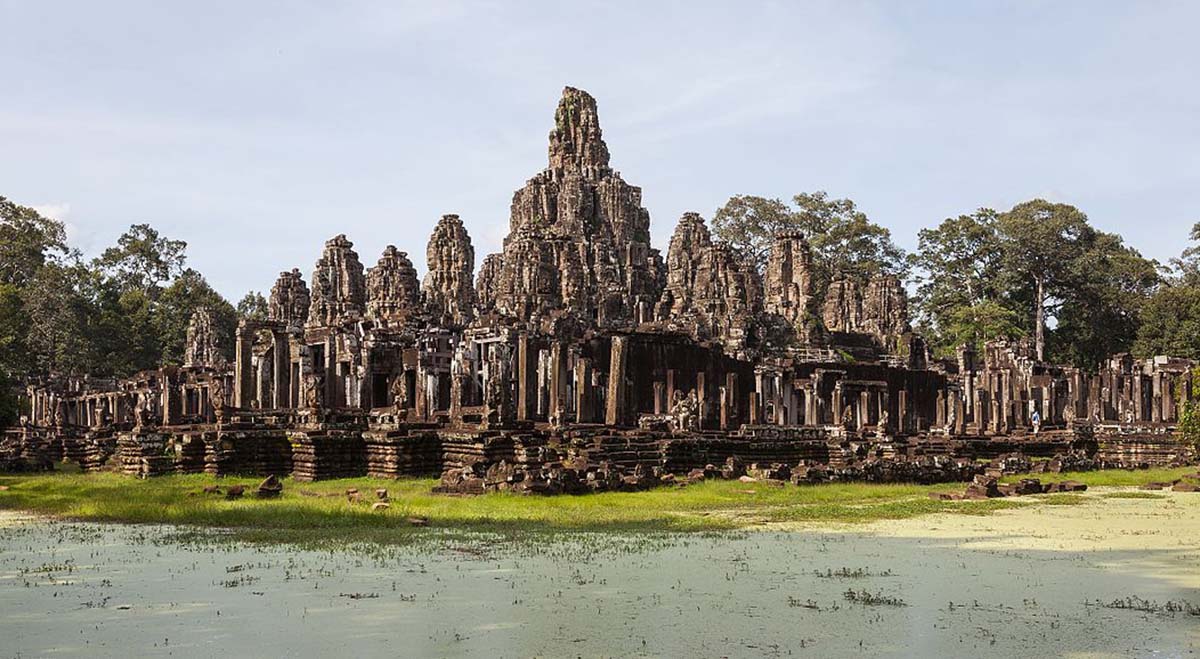
by Jonathon Engels
Angkor Wat is the largest religious monument in the world, with skillful carvings adorning every block in the place. However, my most memorable moments spent in Siem Reap did not happen in Angkor Wat but in the sights that surround it. For nearly a week, tucked into the back of a privately rented tuk-tuk, my wife Emma and I drove our chauffeur to the boundaries of sanity. There was no place we weren’t willing to have Lee take us.
1: Angkor Thom
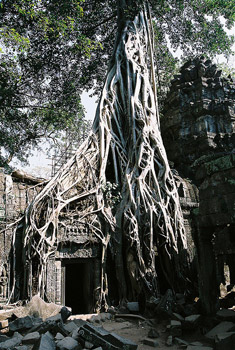 The entry towers at Angkor Thom are among the most photographed relics in Cambodia. Stuck in traffic on the causeway bridge leading to a towered entrance, Lee told us about how the statues—fearsome demons on the right of the bridge, confident gods to the left—had been decapitated only a few decades ago by the Khmer Rouge. Simulating a dagger across the neck, he alleged thieves are still smuggling pieces across the border to Thailand for black market sales.
The entry towers at Angkor Thom are among the most photographed relics in Cambodia. Stuck in traffic on the causeway bridge leading to a towered entrance, Lee told us about how the statues—fearsome demons on the right of the bridge, confident gods to the left—had been decapitated only a few decades ago by the Khmer Rouge. Simulating a dagger across the neck, he alleged thieves are still smuggling pieces across the border to Thailand for black market sales.
Angkor Thom is nine square kilometers of walled city with a huge moat, a dozen temples, and statues around every corner. Inside, children are everywhere vying to be in photos, after which they charge a dollar. One boy, joined by a worrisome number of friends, showed us a statue of an elephant “hidden” behind one of the temples. The special viewing was not free of charge. Our entrepreneurial guide wanted his tip and so did all the boys that came along.
*Also, make sure to go to Preah Kahn, just northeast of Angkor Thom, for the famous tree on the temple photo. Preah Kahn is perhaps the most stunning of all the temples because it is being overrun with vegetation. It’s a great place to explore, ducking under branches and climbing over roots, discovering photogenic spreads in every corner.
2: The Floating Village of Tonle Sap
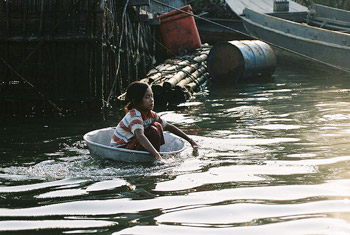 It would be difficult not to notice the intense poverty and hardship of Cambodia, even in an area like Siem Reap, exploding with resort hotels. People beg in heartbreaking fashion. Tuk-tuks are kitted out with signs to notify that this particular driver will not take passengers to underage sex dens. The maiming effects of the Khmer Rouge are evident everywhere. For us, the extent of poverty didn’t fully resonate until the ride south to the waterways of Tonle Sap: Houses along the roads were simply raised platforms with roofs, no walls to block us from seeing in.
It would be difficult not to notice the intense poverty and hardship of Cambodia, even in an area like Siem Reap, exploding with resort hotels. People beg in heartbreaking fashion. Tuk-tuks are kitted out with signs to notify that this particular driver will not take passengers to underage sex dens. The maiming effects of the Khmer Rouge are evident everywhere. For us, the extent of poverty didn’t fully resonate until the ride south to the waterways of Tonle Sap: Houses along the roads were simply raised platforms with roofs, no walls to block us from seeing in.
Tonle Sap is a fluctuating mass of water than shrinks to about 2700 km2 (1675 miles2) of meter-deep water for much of the year, but it swells to over five times that size and up to nine meters deep during rainy season. Designated a UNESCO biosphere, it supplies most of the freshwater fish in Cambodia, as well as half of the flow to the Mekong Delta in Vietnam. The waters support over three million people. For these reasons, it’s an interesting enough place to visit.
That said, the Floating Village is without a doubt something once a bit unbelievable turned into a tourist highlight. The boat trolled between houses that were indeed weaving and bobbing on water’s surface, but our “tour” consisted of going to a souvenir shop/crocodile farm. Even so, it was pretty cool to see children sitting in empty washtubs to paddle from one home to another.
3: Beng Melea
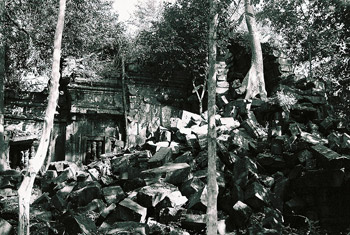 Lee tried to talk us out of it, but he conceded to our wishes. The progression of places we’d chosen that day meant that he was going to have to use a pot-holed dirt road rather than a new, nicely paved one. And, we got a flat in…somewhere, Cambodia. Lee unhooked the trailer, and a roadside worker carted it off by hand. We were not in Siem Reap anymore. From the depths of a dirt road to nowhere, a bike drove by with two full-sized upturned pigs strapped to the back, grunting over each pothole. There was no other traffic for the hour it took to get back on track.
Lee tried to talk us out of it, but he conceded to our wishes. The progression of places we’d chosen that day meant that he was going to have to use a pot-holed dirt road rather than a new, nicely paved one. And, we got a flat in…somewhere, Cambodia. Lee unhooked the trailer, and a roadside worker carted it off by hand. We were not in Siem Reap anymore. From the depths of a dirt road to nowhere, a bike drove by with two full-sized upturned pigs strapped to the back, grunting over each pothole. There was no other traffic for the hour it took to get back on track.
Only a round fifty miles from Siem Reap, the “staff”, a few folks hanging out at the front of Beng Melea, far outnumbered the guests. A little old lady showed us around, Lee included. A kids’ film, Two Brothers, had been recently filmed there, so the sturdy wooden platforms used for moving equipment now acted as comfortable viewing posts. At the end of the last platform, our guide simply stepped off onto the mountainous pile of sandstone blocks.
Beng Melea is absolutely in shambles, only the occasional wall standing amongst a collection of rubble. Our guide took us clambering, jumping, dropping, and discovering. It was as if no one else even knew the place existed, that we were there, or the high likelihood one of us—both in flip-flops—was going to take a pretty intimidating tumble. We didn’t. Instead, we sat atop the western edge of the ruins for a quiet picinic.
Unsurprisingly, the ride home, on that nice paved road, suggested Lee may have been right.
4: The Cambodian Landmine Museum Relief Facility
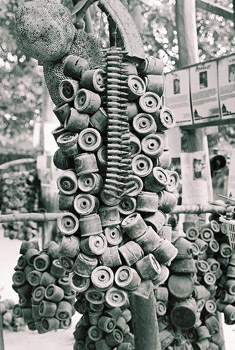 Leading up to our trip, Emma and I had read an incredible memoir, ‘First They Killed My Father’, about a young girl who survived capture by the Khmer Rouge and life in camps where kidnapped children were forced to be soldiers, brainwashed and made to do unspeakable things. Aki Ra was one of these child soldiers, but in 1997 he went back to villages where he had once set up thousands of mines and, working by hand and homemade tools, started defusing them.
Leading up to our trip, Emma and I had read an incredible memoir, ‘First They Killed My Father’, about a young girl who survived capture by the Khmer Rouge and life in camps where kidnapped children were forced to be soldiers, brainwashed and made to do unspeakable things. Aki Ra was one of these child soldiers, but in 1997 he went back to villages where he had once set up thousands of mines and, working by hand and homemade tools, started defusing them.
The project garnered amazing international support, and now Aki Ra runs the Landmine Museum just outside of Seim Reap and continues the perilous task of ridding fields of landmines. On the day we went, Aki Ra wasn’t there because he was out clearing mines. Nevertheless, we got the point. Not the typical museum, this place was basically a massive outdoor collection of the thousands upon thousands of defused landmines. Everywhere — hanging from posts, balled on the ground — were clusters of different types of mines. It was horrifying.
In addition, the Landmine Museum also houses more than forty children and supports a community of seventy-five people. Originally, Aki Ra began by adopting children who’d been wounded by landmines, but now the center takes in children suffering from whatever difficulties. On site, there is a school, complete with a computer lab, a library, English classes, and a playground.
5: Kbal Spean, The River of a Thousand Lingas
 When we reached the end of the pavement, Lee pulled over, unhitched the tuk-tuk, and told us to climb on the bike with him. The road ahead was far too rough, so there we were, Lee on the front, Emma squeezed between us, and me with my hands vice-gripped to the back of the seat. Truth be told, the road was so rough that, for the bulk of the ride, Lee drove in the ditch and on the embankment running alongside the street. I don’t really remember how long the ride took—less than an hour—as I was concentrating on not popping of the back.
When we reached the end of the pavement, Lee pulled over, unhitched the tuk-tuk, and told us to climb on the bike with him. The road ahead was far too rough, so there we were, Lee on the front, Emma squeezed between us, and me with my hands vice-gripped to the back of the seat. Truth be told, the road was so rough that, for the bulk of the ride, Lee drove in the ditch and on the embankment running alongside the street. I don’t really remember how long the ride took—less than an hour—as I was concentrating on not popping of the back.
We eventually arrived at a little trailhead where two statues stood. Again, there were very few visitors as we wound our way down the dirt path to a small tributary of Siem Reap River, but the Kbal Spean site has several highlights, including a waterfall, sandstone sculptures from Hindu mythology, and a carved river bed. Many rocks on the banks have incredible depictions of gods, animals, and people, but the river bed steals the show: Water bubbles over varying patterns chiseled into long stretches of stone.
The ride back proved just as much fun. Emma had never been on a motorcycle before, so she spent most of the ride with her head poked to either side of Lee’s, excited by all the scenery. When we finally stopped, Emma and I got off the bike, dusting ourselves clean, but Lee burst into laughter. Emma had taken off her sunglasses, and there was a thick monobrow of dirt that had formed just above the top of those shades. Worse, there was no water around to clean it off.
After four days of chauffeuring us around, Lee dropped us off at the front of our hostel for the final time. Both Emma and I, at the beginning of our trip, prone to bonding a little more readily than a local tour guide might be, had tiny lumps in our throats. We asked him how much for the week, and in true Southeast Asian style, he replied, “What do you want to pay?” I guess he’d seen it all before.
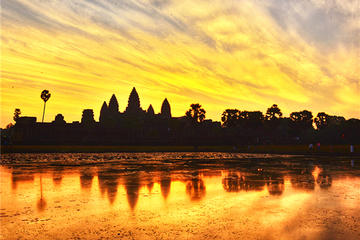
4-Day Siem Reap Tour: Angkor Wat & Angkor Thom
If You Go:
Worthy Causes in Cambodia
♦ Cambodian Landmine Museum and School – Founded by a former Khmer Rouge child soldier (suppressed into service), this Cambodian-run NGO is dedicated to removing landmines, educating the world about them, and helping victims of this ongoing problem in Cambodia. Web site: www.cambodialandminemuseum.org
♦ Rosy Guesthouse – Our hostel in Siem Reap was involved with many worthwhile project in the surrounding communities, and through them, we were able to support an NGO working to prevent child exploitation and another providing musical training to mine victims. Web site: rosyguesthouse.com/responsible-toursim
♦ Let Us Create – An NGO in Sihanoukville provides a private space for children to be creative with paints and more. Needy children also get an education (both Khmer and English classes), nutritional support, and health check-ups. Web site: www.letuscreatecambodia.org. For more information, visit: The NGO Forum on Cambodia – www.ngoforum.org.kh/.
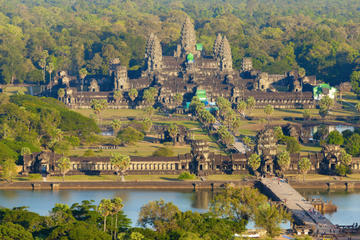
5-Night Cambodia Tour to Angkor Wat from Phnom Penh by Air
About the author:
Jonathon Engels has been an EFL expat since 2005, just after he earned an MFA in creative writing and promptly rejected life as an instructor of freshman comp. He has lived, worked and/or volunteered in seven different countries, traveling his way between them. Currently, he is in Antigua Guatemala, where most mornings he can be found tucked behind a computer in the corner of a coffee shop. For more from Jonathon, check out his website jonathonengels.weebly.com and blog jonathonengels.travellerspoint.com/.
Photo credits:
Bayon, Angkor Thom by Diego Delso / CC BY-SA
All other photos by Jonathan Engels – see more at: www.flickr.com/photos/jengels78/sets/72157633388050634/with/8696493506



Leave a Reply
You must be logged in to post a comment.